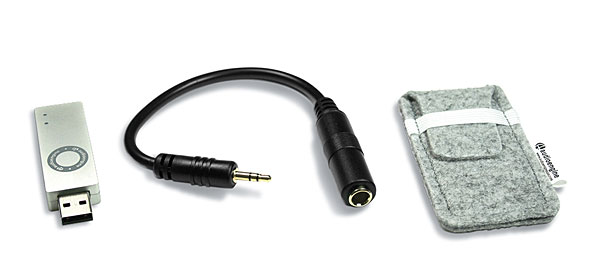Audioengine D3 DAC Headphone Amplifier

AT A GLANCE
Plus
Compact
Inexpensive
Lively sound
Minus
Converts 192-kHz files to
96 kHz
THE VERDICT
The Audioengine D3 is a fine-
sounding entry-level headphone amp as well as the best USB-stick DAC I’ve heard so far.
If you find the whole concept of a headphone amp scary, Audioengine’s D3 might be comforting. It takes the form of a USB stick with a USB plug at one end and a 1/8-inch minijack at the other. Mediating discreetly between your computer and headphones, it gets far better sound out of your computer than you’d get from the computer’s potentially messy analog output.
The D3’s casing is aluminum, not plastic, with a solid feel. It has white and blue LED indicators for power and higher-res sampling rates, respectively, and no volume keys. What Audioengine describes as a “digitally controlled analog volume control” is adjustable through your computer’s operating system and music playback software. The D3 pads the bit depth of everything to 24 bits. While this isn’t necessarily a disadvantage, it precludes the option of listening to a file at its native bit depth.
The D3 powers itself from the computer’s USB port—unlike the other two amps, with their awkward wall-wart power supplies. Its internal power supply sits on a separate board and has two stages of regulation to prevent power fluctuations in the USB bus from affecting performance. It runs a little warm but not excessively.
If you’re familiar with Audioengine’s powered speakers—and the gentle top-end rolloff that makes them so amiable and unfatiguing—you might be surprised how vibrantly the D3 delivers its upper midrange and highs. It doesn’t sound at all like an underpowered portable device. The highs are zingy but not tizzy, the mids are detailed but not overbaked, and bass is decently proportioned. Everything is surprisingly clean and smooth, in stark contrast to the garbage most computers would normally shovel out.

The D3’s overall tonal balance stayed on the pragmatic side of revealing with the Sennheiser and Audeze headphones, though it had a classic sizzle-and-boom moment with the Sony. In Led Zeppelin’s “No Quarter,” John Paul Jones’ keyboard bass was thrillingly deep and full, but when Jimmy Page started his scorching wah-wah guitar solo, I had to cut the volume. The (more expensive) Sennheiser and Audeze ‘phones kept the frequency spectrum in better balance on this track (and most others).
More fiery moments came with Igor Zhukov’s loud steel-fingered trills in the Scriabin piano sonata. The saturation of either the microphones or the analog master tape is audible with any equipment, but again the Audioengine/Sony combo pushed it over the top. They also accentuated the vocal processing in the Bob Marley track. However, these problems receded when obvious distortion or coloration wasn’t actually baked into the recording. In the Nataly Dawn track, the string section and guitars rise to a wailing peak that’s beautifully recorded, and all three headphones plunged me into the maelstrom with no discomfort.
In the Beethoven Fifth, the D3 summoned a sumptuous string sound, in good balance with the other orchestral sections, and it didn’t neglect the ringing triangle in Tchaikovsky’s “Waltz of the Flowers.” The Sennheiser and Audeze—which usually sounded more alike than different—had an edge in warmth and spaciousness, but given their higher prices, that’s to be expected.
The D3 compares favorably with the two USB-stick DACs I’ve reviewed in the past. I found it smoother and less bright than Cambridge Audio’s same-priced DACmagic XS, though it lacks the latter’s hard volume keys. And I thought its midrange was more nuanced than that of the AudioQuest DragonFly ($99 for the original model, $149 for version 1.2), though they had a similar overall feel, and I should qualify by noting that I haven’t tried the updated version of the DragonFly.
Audioengine’s D3 is the best stick-type USB DAC and headphone amp I’ve heard yet. It sports a nearly nothing form factor and blissful independence from cumbersome USB-driver installation and wall warts. Its five-star performance rating—relative to similarly priced products—is well earned. If you’re looking for the easiest, cheapest way to make computer audio sound great through headphones, this is it.
Read the full story, "Supercharge Your Headphones: 3 DAC/Headphone Amps Put to the Test" here



























































